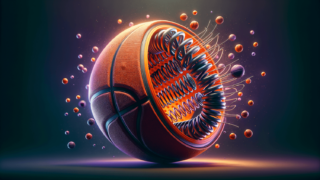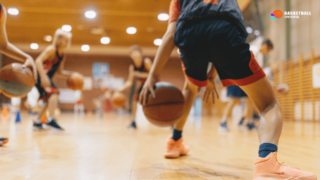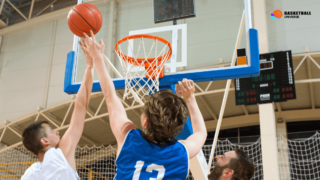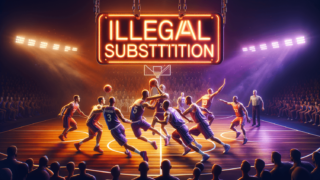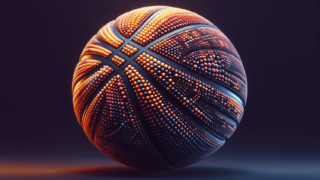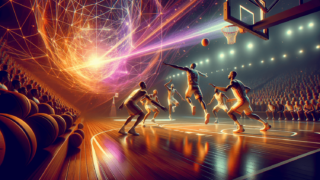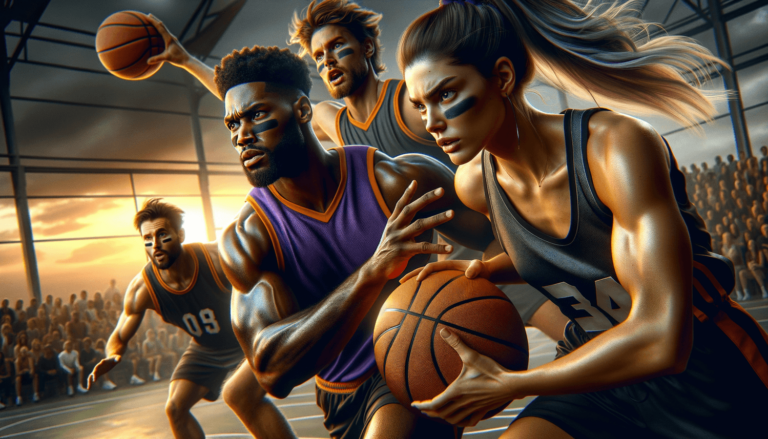
When it comes to accessorizing, basketball players have been known to don some eye-catching gear— from flashy sneakers to custom mouthguards. One question that often pops up among fans and players alike is, do basketball players wear eye black? Before we dive into this fascinating topic, let’s take a moment to understand the purpose of eye black and how it has become synonymous with other sports. Sit back, relax, and get ready for a fun, professional exploration of this intriguing aspect of basketball attire.
Do Basketball Players Wear Eye Black?
In general, basketball players do not wear eye black. Unlike sports like football and baseball, where the primary purpose of eye black is to reduce glare from the sun or stadium lights, basketball takes place indoors where glare is not a significant issue. Additionally, wearing eye black could be considered a violation of uniform regulations in some competitive leagues. Thus, you are unlikely to see basketball players donning eye black on the court.
Origins and Purpose of Eye Black
Eye black is a grease or strip applied under the eyes to reduce glare from the sun or stadium lights. The concept of using a dark substance under the eyes for this purpose stems from the natural, inbuilt anti-glare protection seen in many animals that have dark fur, called “furcular markings.” Baseball and football players use it extensively, as they often play in outdoor arenas where bright sunlight or powerful artificial lights could impair their vision. Understanding the origin and purpose of eye black helps us appreciate why it doesn’t have an established presence in basketball.
Indoor Nature of Basketball
Basketball is an indoor sport played in well-lit arenas, without the direct glare of sunlight that might necessitate the use of eye black. Stadium lighting in basketball arenas is intentionally designed to avoid creating excessive glare, which can distract or impair the players’ vision. In fact, aside from a few exhibition games, professional leagues like the NBA rarely hold outdoor games. Therefore, one primary reason basketball players don’t wear eye black is that the indoor nature of the sport makes it unnecessary for glare reduction.
Basketball League Uniform Regulations
Another significant factor is that applying eye black might be considered a violation of uniform regulations in competitive basketball leagues, such as the NBA. These rules help maintain uniformity among players’ appearances and avoid potential distractions on the court. Let’s dive deeper into some of the most notable aspects of basketball uniform regulations:
General Appearance
Uniform regulations generally emphasize maintaining a clean and professional appearance, preventing players from wearing excessive items or accessories that don’t contribute to their performance. In most cases, eye black would fall into the category of an unnecessary accessory, disqualifying its usage under league rules.
Game Uniforms
Basketball uniforms typically consist of a jersey and shorts, designed to offer comfort, breathability, and freedom of movement. Logos and uniform designs must comply with the specific league’s requirements, ensuring a consistent appearance among players. As eye black falls outside the standard game uniform specifications, it is generally not allowed.
Accessories
When it comes to accessories, basketball players usually wear items like headbands, armbands, wristbands, and compression sleeves, primarily for sweat management or injury prevention. However, even these accessories are regulated to match team colors and maintain a specific look. Given that eye black doesn’t have a specific function in basketball, it is unlikely to be allowed as part of the approved accessories.
Alternatives to Eye Black in Basketball
Since basketball players don’t wear eye black, what do they use to manage glare, sweat, or visibility issues? Let’s explore some popular alternatives:
Headbands
Headbands help wick away sweat and prevent it from dripping into the eyes, which could impair vision or cause discomfort. Made of absorbent material, these accessories are a staple for many basketball players and are allowed within league regulations as long as they match team colors.
Shooting Sleeves
Although not directly related to glare or visibility, shooting sleeves are an iconic accessory among basketball players. They help promote blood circulation, keep muscles warm, and provide compression that aids in injury prevention. Additionally, they may offer an extra degree of control during shoots and dribbles. Like headbands, shooting sleeves must comply with league regulations and team color schemes.
Mouthguards
Most basketball players wear mouthguards to protect their teeth from injury during physical contact or unexpected collisions on the court. Unlike eye black, which serves no protective function, mouthguards are vital to player safety and are widely accepted across various leagues.
Protective Eyewear
In some cases, players wear protective eyewear, such as goggles or prescription glasses, to shield their eyes from potential injuries, manage glare, or correct vision problems. These are allowed, provided they meet league regulations and don’t pose a risk to other players on the court.
Why Other Sports Make Use of Eye Black
As mentioned before, eye black is quite popular in sports like baseball, football, and even some extreme outdoor activities, such as mountain climbing. In these sports or activities, eye black serves a functional purpose, as glare reduction enhances players’ visual performance. So, let’s explore why eye black is still in use in these other athletic pursuits.
Outdoor Stadiums
Unlike basketball, both baseball and football are primarily played outdoors, where intense sunlight and artificial stadium lighting can create visual obstacles for players. Eye black helps reduce glare, allowing athletes to maintain optimal focus and achieve peak performance in high-stakes situations.
Position-Specific Benefits
Some positions in baseball and football require heightened visual acuity, especially when tracking fast-moving objects, like a baseball or football. For example, a baseball outfielder must be able to track a fly ball across the sky, while a football wide receiver must follow the trajectory of a pass. In these positions, any improvement in visibility can provide a competitive advantage, making eye black an invaluable tool.
Cultural Trends and Personal Preference
Lastly, the use of eye black in sports like baseball and football has also become a cultural norm and personal preference for many athletes. Some players might use eye black for superstitious reasons or simply because they believe in its effectiveness. However, the absence of such a precedent in basketball means that players are less likely to adopt the practice.
In conclusion, basketball players generally do not wear eye black due to the indoor nature of the sport and strict uniform regulations. Instead, they use other accessories like headbands and protective eyewear to manage sweat or glare and maintain optimal visual performance on the court. As the popularity of basketball continues to grow, it is essential to understand and respect the nuances of the sport to appreciate its distinct identity within the realm of athletic competition.
Impact of Eye Black on Performance
Over the years, there has been some debate regarding the actual effectiveness of eye black in improving sports performance. While in-depth research and scientific evidence are limited, a study conducted by Dr. Brian M. DeBroff and Patricia J. Pahk at the Yale Eye Study in 2003 found that the use of eye black could lead to nearly a 10% improvement in contrast sensitivity for glare reduction. This finding provides some concrete support for the use of eye black in outdoor sports like baseball and football, but has little to no relevance for indoor sports like basketball, where glare is not a significant concern.
Eye Black Controversies in Sports
Some controversies have arisen in the sports world due to the use of eye black as a platform for personal expression. Individual players have written text, symbols, or messages on their eye black strips, which can sometimes lead to disputes or sanctions from leagues that seek to prevent political, religious, or social messaging. By not allowing eye black in basketball, potential controversies and distractions are also minimized, promoting a higher level of focus on the game itself.
Sports Where Eye Black Isn’t Common
Basketball isn’t the only sport where eye black isn’t widely utilized. In many such sports, the reasons behind the absence of eye black are similar to those of basketball. A few examples include:
- Ice Hockey: The cold indoor setting and uniform regulations make eye black unnecessary in this high-speed sport.
- Volleyball: While beach volleyball takes place outdoors, the nature of the sport and generally smaller court size means glare reduction is a less critical concern. Additionally, indoor volleyball takes place under controlled lighting conditions, similar to basketball.
- Badminton: Played primarily indoors, badminton does not require eye black due to its controlled lighting conditions and fast-paced gameplay that emphasizes speed and precision over long-distance visibility.
- Swimming: Eye black is not relevant in this aquatic sport, as swimmers generally wear goggles to protect their eyes and maintain clear vision underwater.
The Future of Eye Black in Sports
So, what does the future hold for eye black? While its adoption in basketball seems highly unlikely, it is expected to remain a fixture in outdoor sports like baseball and football. As technology advances, new eye black formulations may be developed to enhance glare reduction and contrast sensitivity further, which would make the product even more attractive to athletes across various sports. In the meantime, basketball players will continue to rely on alternative accessories like headbands, mouthguards, and protective eyewear to optimize their performance and maintain a professional appearance on the court.
Frequently Asked Questions
We understand that you may still have some questions related to eye black and its use in basketball and other sports. To help you become an expert on the topic, we’ve compiled a list of frequently asked questions, complete with concise, NLP-style answers:
1. What is the main purpose of wearing eye black?
The primary purpose of wearing eye black is to reduce glare from sunlight or artificial light sources, thus enhancing athletes’ visual performance and contrast sensitivity in outdoor sports like baseball and football.
2. Do any professional basketball players wear eye black?
No, professional basketball players generally do not wear eye black, as the sport is played indoors under controlled lighting conditions and the use of eye black is not allowed by uniform regulations in competitive leagues like the NBA.
3. Can eye black help in night games?
Yes, eye black can be helpful during night games in outdoor sports, as it can help reduce glare from powerful stadium lights, resulting in better visibility for the athletes.
4. What is eye black made from?
Traditional eye black is made from a mixture of beeswax, paraffin, and carbon, while modern formulations may include additional ingredients such as natural oils, silicone, or antioxidants.
5. Is eye black approved by sports leagues?
Eye black is generally approved for use by certain outdoor sports leagues like Major League Baseball (MLB) and the National Football League (NFL), where glare is a concern. However, it is not approved for use in basketball and some other indoor sports where glare is not a significant issue.
6. Can I wear eye black in a recreational basketball game?
While you might not be breaking any formal rules in a recreational basketball game, wearing eye black is unlikely to provide any significant advantages, as glare is not a prevalent issue in indoor settings. In most cases, wearing eye black would be unnecessary and potentially distracting for other players.
7. Is there a scientific basis for the effectiveness of eye black?
A study conducted by Dr. Brian M. DeBroff and Patricia J. Pahk at the Yale Eye Study in 2003 found that eye black could improve contrast sensitivity by nearly 10% for glare reduction. This finding offers some scientific support for the use of eye black in sports played outdoors, where glare is a concern.
8. Can eye black be harmful to the skin?
Eye black is generally considered safe for the skin, as it is made from non-toxic ingredients such as beeswax, paraffin, and carbon. However, it is important to patch test any product and ensure that you are not allergic to any of its ingredients before use. If skin irritation occurs, discontinue use and consult a medical professional.
9. What are the alternatives to eye black for glare reduction in sports?
Alternatives to eye black for glare reduction can include wearing caps, visors, or sunglasses that shield the eyes from sunlight or artificial light, and using tinted safety sports goggles designed for glare management.
10. Can eye black be removed easily?
Yes, eye black can typically be removed easily using soap and water or a gentle makeup remover. Make sure to clean your skin thoroughly after use to avoid potential skin irritation or clogged pores.
11. Are there adhesive eye black strips available?
Yes, adhesive eye black strips are available for those who prefer a mess-free alternative to traditional eye black grease. These strips often come in different colors and designs, helping athletes express their individuality while also serving the functional purpose of glare reduction.
12. Is eye black used in any other activities besides sports?
Eye black may also be used in activities such as hunting, fishing, or mountain climbing to reduce glare and enhance visibility in outdoor settings. However, its primary use remains in sports like baseball and football.
13. What are the alternatives to eye black in basketball for managing visibility and sweat?
In basketball, players generally use alternatives like headbands, wristbands, and protective eyewear to manage sweat, glare, and visibility issues, as eye black is not necessary or allowed in the sport.
Featured Posts
- No pillar pages found.
